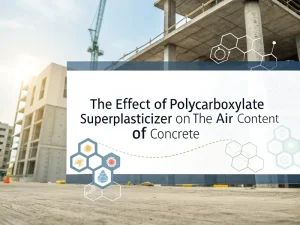
Can Polycarboxylate Superplasticizer Reduce The Water Cement Ratio Of Concrete?
Blog Can polycarboxylate
Blog

Superplasticizer is an essential additive in modern concrete production, playing a crucial role in improving the workability and strength of concrete. Many people are unaware of the names of superplasticizers used in concrete, and this article will provide answers.
Superplasticizer is a general term that comes in various types, each with a unique chemical composition and uses:
Polycarboxylate ether superplasticizers are high-performance additives with a complex molecular structure. They are typically composed of main polymer chains with polyether functional side chains. The length and density of these side chains can be adjusted during the synthesis process to fine-tune the superplasticizer’s performance.
Polycarboxylate ether superplasticizer works through a combination of steric hindrance and electrostatic repulsion. When added to concrete mixtures, superplasticizer molecules will adsorb onto the surface of cement particles. The long polyether side chains extend into the surrounding water, forming a spatial barrier to prevent cement particles from aggregating together.
In addition, the anionic groups on PCE molecules provide electrostatic repulsion, further dispersing cement particles. This results in a significant decrease in the water-cement ratio while maintaining excellent workability.
High-strength concrete: PCE, a high-efficiency water-reducing agent, is widely used in the production of high-strength concrete, and a low water-to-cement ratio is crucial for achieving high compressive strength.
Self-compacting concrete: Self-compacting concrete requires a high degree of fluidity to flow and fill the formwork without the need for mechanical vibration. PCE superplasticizer is an ideal choice for this application, as its working mechanism can improve the fluidity of concrete and avoid segregation.
Sulfonated melamine formaldehyde is formed by the reaction of melamine and formaldehyde followed by sulfonation. The resulting product is a linear polymer with sulfonic acid groups attached to the melamine formaldehyde skeleton.
General construction projects: SMF is usually used for general construction projects that require moderate improvement in workability and reduction of the water-cement ratio. It is suitable for applications such as residential buildings, small commercial structures, and road construction.
Concrete with medium strength requirements: For concrete with strength requirements within the range of 30-50MPa, an SMF high-efficiency water reducer can effectively improve the workability and strength of the concrete. They are a cost-effective choice for projects that do not require high-performance PCE superplasticizers.
Sulfonated naphthalene formaldehyde is synthesized by reacting naphthalene with formaldehyde and then sulfonating. The polymer obtained has a branched structure with sulfonic acid groups, which is why it is superplastic.
Similar to SMF superplasticizer, the working principle of SNF superplasticizer is electrostatic repulsion. The sulfonic acid groups on polymer molecules give cement particles a negative charge, causing them to repel each other and disperse in the concrete mixture. This leads to decreased water-cement ratios and improved workability, enhancing concrete strength and durability and increasing solidification time.
Prefabricated concrete products: SNF high-efficiency water reducers are commonly used in the production of prefabricated concrete products, such as concrete blocks, pipes, and slabs. They help achieve a high degree of processability in the manufacturing process, ensuring the correct filling of molds and the production of high-quality prefabricated components.
Concrete in industrial applications: In industrial applications where concrete is exposed to moderate levels of wear, SNF superplasticizer can improve its strength and durability. For example, in the construction of factory workshops and industrial warehouses, SNF-treated concrete can withstand heavy loads and mechanical wear.
Lignosulfonate is a byproduct of the pulp and paper industry. It is a complex polymer derived from lignin, the main component of wood. Lignosulfonate-based high-efficiency water-reducing agents are usually modified by adding functional groups to improve their performance.
Lignosulfonate work by adsorbing on the surface of cement particles. They reduce the surface tension between cement particles and water, which helps with their dispersion. In addition, they can form a thin film around cement particles, providing a lubricating effect and improving the workability of concrete.
Economic concrete mixture: Lignosulfonate-based, high-efficiency water-reducing agents are commonly used in economic concrete mixtures, with cost-effectiveness being the primary consideration. They can improve processability and reduce the water-cement ratio relatively cheaply. In small-scale projects such as home decoration and rural infrastructure construction, lignin sulfonate-based high-efficiency water-reducing agents are a feasible choice.
Road construction concrete: In road construction, lignin sulfonate-based high-efficiency water-reducing agents can improve the workability of concrete, making it easier to pour and repair. They can also improve the durability of concrete pavement by reducing the water-cement ratio, which helps prevent the entry of water and harmful chemicals.
Strength requirements: For high-strength concrete applications, PCE superplasticizers are usually the preferred choice because they can achieve very low water-cement ratios. However, for projects with moderate strength requirements, SMF, SNF, or lignosulfonate-based high-efficiency water reducers may be sufficient and more cost-effective.
Job performance requirements: If concrete requires high fluidity, such as in self-compacting concrete applications, PCE’s high-efficiency water-reducing agent is very effective. For general construction projects that require more moderation and ease, other types of high-efficiency water-reducing agents can be considered.
Durability requirement: In environments exposed to harsh conditions such as freeze-thaw cycles, chemical erosion, or high humidity, high-efficiency water reducers such as PCE and SMF are more suitable for reducing water-cement ratio and increasing concrete density.
It is crucial to ensure the compatibility between superplasticizers and the types of cement used in concrete mixtures. Different types of cement may have different chemical compositions and particle sizes, which can affect the performance of high-efficiency water-reducing agents. In addition, if other admixtures, such as air-entraining agents or retarders, are used in the concrete, superplasticizers should be compatible with them to avoid any adverse effects on the concrete’s performance.
The cost of high-efficiency water-reducing agents is essential in the selection process. Although PCE high-efficiency water-reducing agents have high performance, they may be more expensive than other types. In projects where cost is a significant constraint, but performance requirements can be met with cheaper high-efficiency water reducers such as lignin sulfonate-based or SNF high-efficiency water reducers, these options should be considered. However, balancing cost and concrete’s long-term performance and durability is crucial.
Choosing the appropriate high-efficiency water-reducing agent for concrete is crucial for achieving the desired workability, strength, and durability. The most commonly used high-efficiency water-reducing agents include PCE, SNF, SMF, and lignosulfonates, each of which can meet different building needs.

Can Polycarboxylate Superplasticizer Reduce The Water Cement Ratio Of Concrete?
Blog Can polycarboxylate

The Effect Of Polycarboxylate Superplasticizer On The Air Content Of Concrete
Blog The effect of polyca